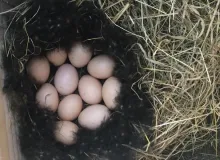
Hottentot Teal (Anas hottentota)
Species name
- Dutch name:
- Hottentottaling
- English name:
- Hottentot Teal
- German name:
- Hottentottenente
- French name:
- Sarcelle hottentote
- Scientific name:
- Anas hottentota
Scientific classification
- Order:
- Anseriformes
- Family:
- Anatidae
- Onderfamilie:
- Anatinae
- Genus:
- Anas
Description
- Description:
Male:
Orsal head from eye upward, and hind neck black-brown, ventral head, sides and fore-neck buff with dusky patch on sides of upper neck. Breast and underparts buff with dark brown spots, largest on fore flanks; rear flanks plain buff. Rump blackish, tail-coverts and hind abdomen/ventral region vermiculated buff and blackish. Upperparts dark brown with greyish edges to feathers. Wing black-brown with faint green-blue gloss, secondaries metallic green, black sub terminal band, broad white tips.Female:
The female is duller, crown browner, patch on neck less defined, scapulars shorter, ventral region not vermiculated, seconderies browner.Juvenile:
Same as female but less marked. Appear as adults by first breeding season.
Standard Measurements
- Body Length (cm):
- The male (drake) of the Hottentot Teal measures approximately 330-350 centimeters. The female measures approximately 330-350 centimeters.
- Body Weight (grams):
- The male will weight about 216-282 gram. The female will weight about 224-253 gram.
The weight is notoriously variable and can only be used as indication!
- Note:
Dabbling Ducks are generally hardy, easy to maintain and easy to breed. Shelter may be required by some of the smaller species in winter. They should be provided with cover (including marginal pond cover) and loafing areas as well as water. A pen which is 50% water is suggested. The water may be shallow (i.e. no more than two feet deep is required), and muddy areas for dabbling in are also appreciated. These ducks are generally good in mixed collections, although the smaller and quieter species may be bullied. Territorial disputes between ducks of the same species may be avoided by keeping only one pair of each species in an enclosure, unless the area is very large. For a single pair of ducks a pen are of 50 to 100 square metres, depending on the size of duck, should be provided.
A diet based on wheat and pellets is suggested, with maintenance pellets changed to breeders pellets for the breeding season. Bread and greenfood are also appreciated. Grit should always be available, with soluble grit (e.g. oystershell grit) as a calcium source when breeding.
Most species are ground nesters and both close ground cover and ground level nest boxes should be provided. Hand-rearing is generally preferred, as these ducks are generally poor parents in captive conditions, particularly in enclosures shared with other waterfowl. These ducks are prone to hybridization, particularly with closely related species, which should be kept apart from one another.
Generally hardy and easy to manage. Sunny, sheltered enclosures suggested, with winter shelter; warmer winter quarters may be required in cold climates. Feed as other dabbling ducks: graint, pellets, greenfood, grass, appreciate duckweed and floating aquatic vegetation.
Require a quiet secluded pen for breeding, with no competition; plenty of ground cover should be provided for nesting as well as both ground level and elevated nest boxes. If kept in the open, eggs may be laid in summer, e.g. July, or earlier e.g. April to May. May be parent or broody reared, although hand-rearing has been recommended, as the ducklings require much warmth.
Hybrids reported with Silver teal (Anas versicolor) and Wood duck (Aix sponsa).
- Breeding:
- The female Hottentot Teal usually lays from 6-8 cream, light brown or yellow-buff eggs and incubates them for 24-27 days.
- Artificial incubating:
The ideal relative humidity for incubating most waterfowl eggs is 55% (ground nesters) and 40% (cavity nesters). The temperature is usually 37.4°C. Set ventilation as recommended by the incubator manufacturer. Eggs must be turned, either automatically or by hand, a minimum of 4 times a day. As the duckling develops there is a loss of water from the egg and the air sac gets bigger. In normal development of an egg with a 24-27 days incubation, the air sac occupies about a third of it three days earlier. Cleanliness is vital and ideally eggs should be moved to a separate hatcher at this point, where the humidity should be increased to 65% and even higher once they have pipped internally.
- Bird banding:
- Recommended closed leg band ring size for the Hottentot Teal is 6,5 mm.The leg band ring can only be applied on a young dabbling duck at around 10 days old.
- It doesn't matter what leg that you band, but it's good to have a consistent system. Suggested: Left leg = Female, Right leg = Male
- Rearingfeed:
-
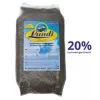
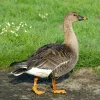

Floatable special rearing feed for all types of aquatic ornamental fowl - especially for the cultivation of trees as well as greening ducks.
This well-balanced complete feed with 20% protein content convinces above all by its good compatibility and forms the basis for visibly healthy growth from day one.
Made exclusively from wholesome and selected raw materials, Lundi Micro Regular is also ideally suited for the year-round feeding of waterfowl.
- Maintenance food:
-



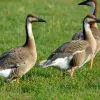

Lundi Regular with a protein content of 20%, valuable Spirulina and high-quality by-products is optimally balanced in its composition maintenance food for water ornamental fowl of all kinds. Especially green teal and Whistling ducks that are not dependent on a very high protein content, are well supplied.
Lundi Regular contains all the minerals and vitamins in full form that are important for the animals. Therefore also suitable as breeding food.


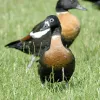


Floating full food for all sea ducks, green ducks, eider ducks and geese, especially in the moulting and breeding phase ideally suited. Packed with wholesome raw materials, natural vitamins and trace elements, this performance food with a protein content of 30% forms the basis for lifelong vitality.


